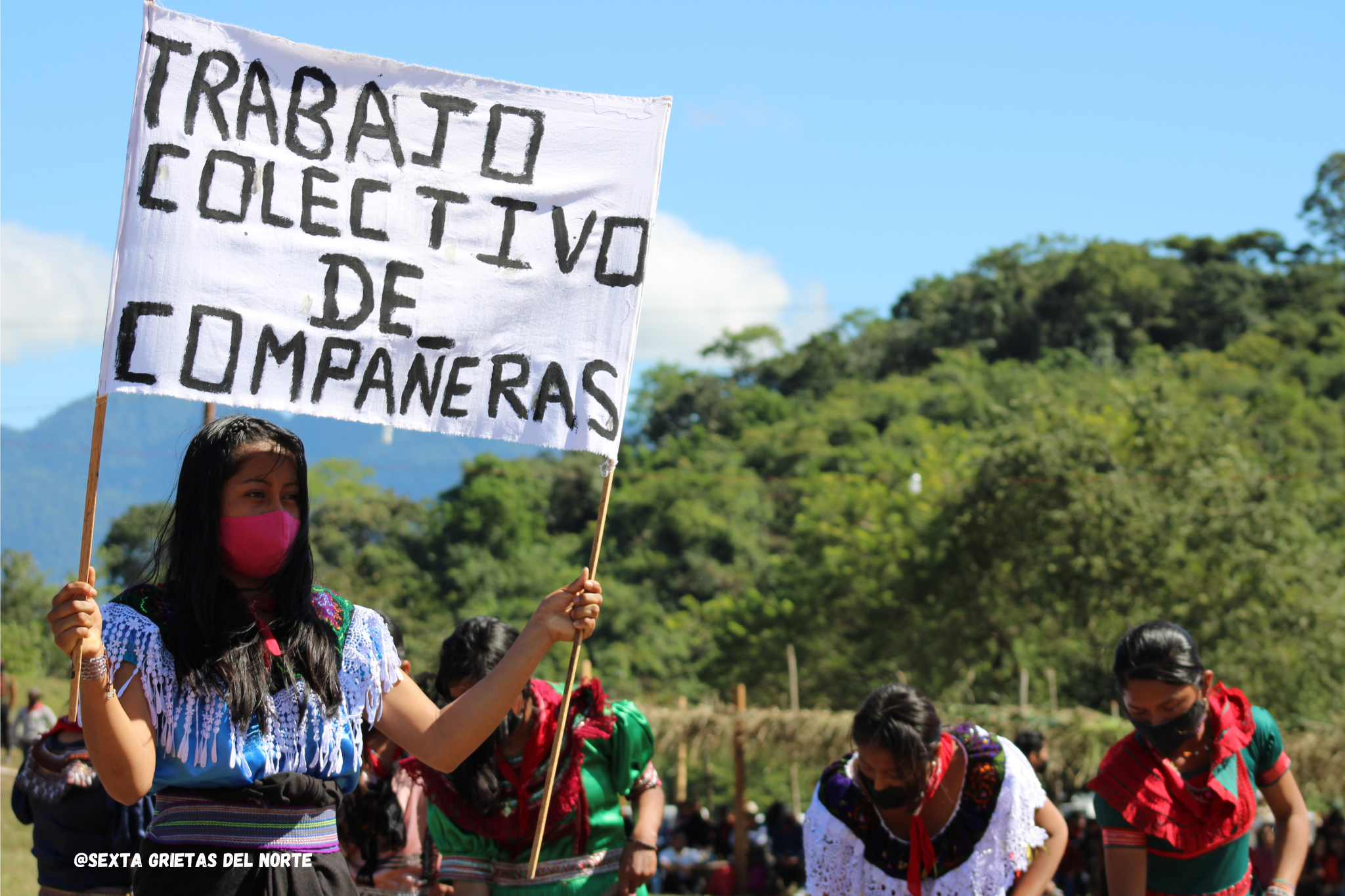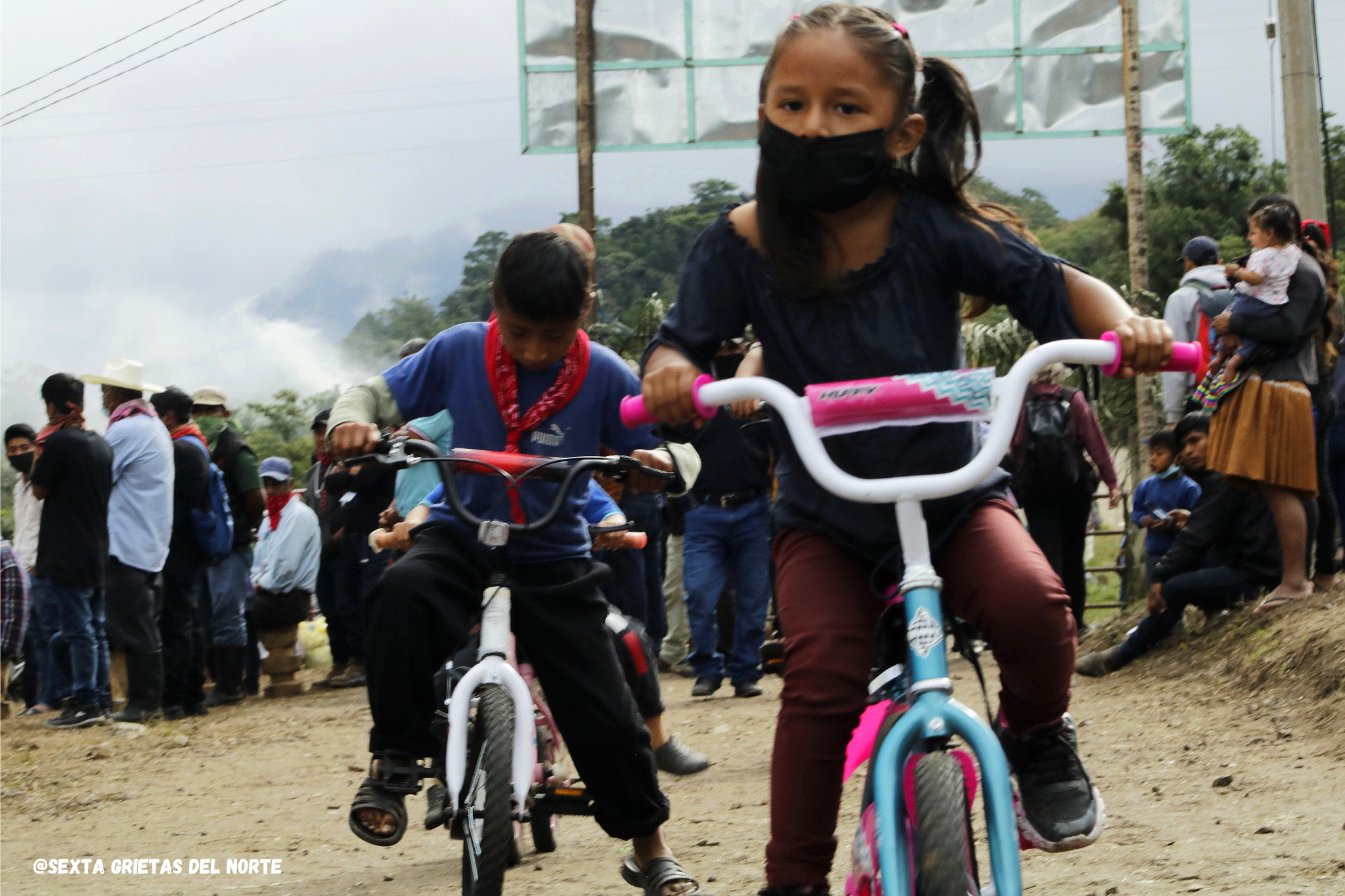
Young Liria nodded excitedly with a smile that lit up her face like the Mayan sun. Her small frame rocked back and forth with emotion. She had been at the 30th anniversary celebration of the EZLN in the Caracol of Dolores Hidalgo, and still vibrated with the energy of it. Along with thousands of her peers, she witnessed as people from around the globe streamed into the remote canyons of Chiapas to celebrate, and to listen to the Zapatista youth as they enacted their stories before an international audience. She witnessed for the first time the global reach of their movement that her grandparents and parents had built, and that she, should she choose to, would be charged with carrying on.
Liria’s community, like communities across Chiapas, are regularly disrupted by violence and threats of displacement. Schools and clinics have been closed due to the strains that insecurity imposes. Community members take turns standing watch to protect their families, in lieu of being able to work in their milpa or attend to their trabajos colectivos or posts in the caracoles. The children are not able to venture far to play, much less study. Travel between regions and to the cities is risky.
In the face of all of this, the Zapatista Bases of Support communities have undertaken a long process of self-critique and evaluation of where their work now stands. Their assessment is that at the heart of the rancor which is tearing people apart, pitting campesino against campesino is, of course, capitalism and its legal trappings. In particular, they point to a “fucking piece of paper,” that which denotes ownership of the land and resources. So, following consultations and assemblies in the Zapatista recuperated lands, the BAEZLN now embark on a new process of organization, in which agreements with their neighbors (non-Zapatistas) declare these lands “common” or “no-one’s land.” The decision marks an aperture derived from their experience with collective work, and their understanding of humanity as the indigenous peoples that they are.
Facing the storm
The prospects of this endeavor?
Having closely observed the audacity, the unmitigated imagination and the tenacity of these communities over the past 30 years, we admit that we are always prepared to stand in wonder.
And on the other hand, much of what we see is a world order stacked against them, against life.
As President Andrés Manuel López Obrador rounds the final stretch of his six-year term, he continues to stoke the dreams of economic “progress” from his initiatives. Both the Tren Maya and the Tren Transístmico launched inaugural runs of at least one line in December. They have perforated cenotes, felled forests, and parceled out communal lands for tourist or industrial development. And yet some communities, too many, hang on the President’s promises of prosperity and modernity.
Mexico continues to stand out globally in some unflattering ways: third most dangerous for environmental defenders; prior to the genocide in Gaza it ranked first or second in the most dangerous for journalists. Collectives of mothers and family members searching the Mexican countryside tell the stories of over 113,000 disappeared.
Currently at the southern border of Chiapas, thousands of families are being forced to flee in terror due to the violent clashes between two cartels invading their communities . They are caught between forced conscription and imminent death. Despite the overwhelming presence of the Army and National Guard in the state (and especially in border areas) nothing is being done to protect the population. The violence in the state is expected to reach a climax as elections approach and power shifts.
The Común

It is in this context that the Zapatista communities, through dialogue with sister communities, sow the seeds of the común. The lands recuperated during the 1994 uprising have been declared “non- property” to be shared by those who are willing to work it, and respect it as the inheritance of the many generations to come. Far from a leap of faith, the declaration of lo común is a serious wager on the challenging work of building common ground —not a task for the faint of heart or of limited endurance. This is a marathon and they know it.
The Zapatistas see that the afflictions of humanity which plague Chiapas and the rest of the world, however different, are the same. They know that even those who act only in their self-interest will come up empty handed in the end. Young people in the movement see that their horizon is seven generations into the future, and that setting the course begins now. Building bridges to that which is common: the love of our children, the need for clean air, water, and food, our kinship with the non-human and the struggle for life. That is the foundation of the road we are on…
A vision of seven generations
Liria came into the city with her companions to run errands for her community, to learn new skills, and also to conocer. Her education, in the milpa, in the classroom, or the streets of the city starts from a place of understanding oneself, where she comes from, her history and the consequences of her actions. With the strength of the generations that came before her, her gaze is on the fruits of her labors on the horizon. She sees in collective spaces our interdependence, and the commitments we must make to benefit the common good.

It is through this lens that Liria comes to know the city for the first time. “This is the first time that I’ve been here,” she emphasized pointing to the sidewalk where we stood in the center of San Cristóbal. Her eyes, wide and hopeful, took in the kaleidoscopic bustle of the street. Street vendors selling all manner of colorful, shiny, salty and sweet, motorcycles, musicians, and the merry-go-round of cosmopolitan comings and goings. She moves confidently, watching in all directions, and glancing back to take stock of her traveling companions, including myself. At 14 years old, in an unfamiliar environment, she has all the bearing of a capable educator, or mother, or engineer, or healer, or whatever she may want to be. She is ready to take on what comes.
It is with tremendous vision, creativity, and dedication that the communities in resistance continue to dream and build the structures of autonomy to sustain life in relationship with Mother Earth, to preserve language and culture and dignity. Their work is local — weaving strand by strand the relationships in their struggle for life and in defense of territory— but their vision is not limited to Chiapas, or to Mexico. Nor is their wager on the común. The work of building autonomy is not about isolation, it is about returning power to peoples and communities, strengthening skills and capabilities to provide for the emerging seeds of a better world, weaving the struggles from below and to the left, and nurturing the many versions and visions of that world which will allow those young women of the future to be free.
Original text by Schools for Chiapas.